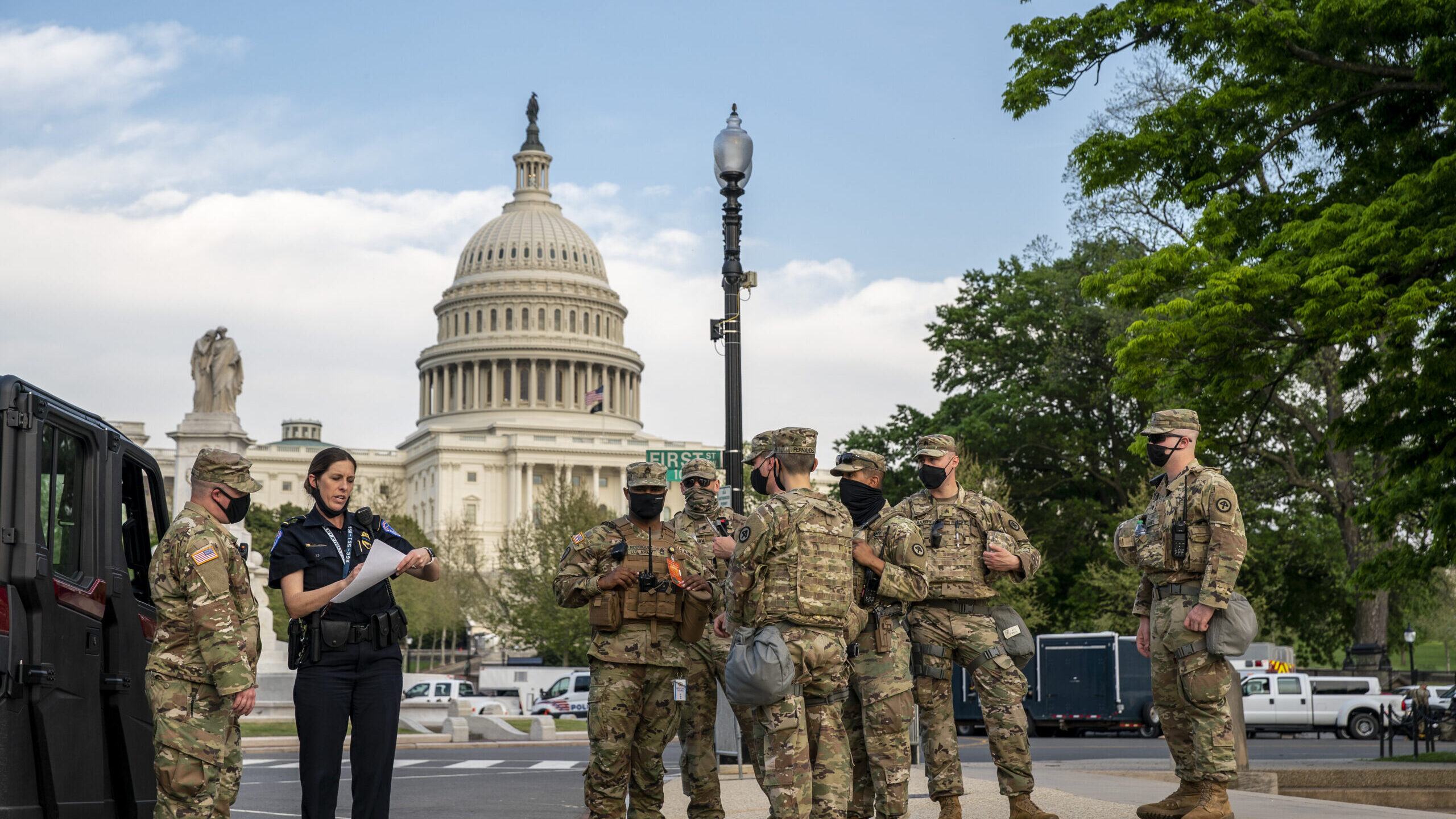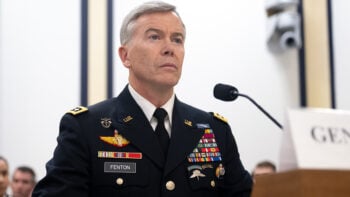
Military personal and Capitol Hill Police department stage outside the US Capitol before U.S. President Joe Biden will address a joint session of Congress in the House chamber of the U.S. Capitol April 28, 2021 in Washington, DC. (Photo by Tasos Katopodis/Getty Images)
With Ukraine running out of ammunition, it’s never been clearer that gridlock in Washington budget processes can injure American interests — and cost lives. In this op-ed from Stephanie Young and Megan McKernan, the two RAND budget experts argue the US needs to look to allies and even non-defense agencies like NASA and HHS for better ways to budget, both to ensure stability on long-term goals and adaptability in response to crisis.
As the US government confronts two near-peer challengers in China and Russia, along with mounting conflict in the Middle East, ensuring stability, predictability, and some measure of flexibility in the US defense budget is more important than ever. Yet the US budgeting system is in a state of disarray.
Gridlock has already led to several will-they-or-won’t-they government shutdowns, short-term stopgap continuing resolutions, and now in the New Year, looming across-the-board budget sequestration for the first time since fiscal 2021. This is bad news not just for the United States, but also for allies and partners, who play essential roles in US national security strategy worldwide and are exposed to serious downstream effects when the Pentagon’s budget house is not in order.
The US now faces a once-in-a generation opportunity to transform the budgeting processes required to make hard choices, align priorities, and execute on them. A congressionally mandated Commission on Planning-Programming-Budgeting and Execution (PPBE) reform was stood up in 2022 to evaluate these problems, and RAND analysis supporting the commission reveals the critical importance of working with allies and partners on the reforms and learning lessons from their successes.
We found international partnership on budgeting reform to be particularly critical in light of the governance and budgeting structures of near-peer challengers, China and Russia. The adversaries certainly have weaknesses— Russia’s corruption, industrial capacity, and supply chain problems are on full display in Ukraine — but they also benefit from centralized systems that lack political opposition, facilitate close alignment between political and military leaders, and allow for sustained investment in long-term planning to reach complex modernization goals in hypersonics and other areas.
So, what can we learn from allies and partners as the US pursues defense budget reform? A main lesson is the need to balance security and stability with a healthy dose of flexibility. Key allies including Australia, the UK, and Canada place a significant emphasis on stability and predictability. They rely on interdependent, co-development efforts — most famously the F-35 — and foreign military sales with the US to promote strategic convergence, interoperability, and the shared benefits of innovation. This means that unpredictability in US PPBE (or partners’ systems) can have downstream implications for the US and its partners.
These countries place a significant emphasis on stability and predictability. Yet for allies and partners, unpredictability can be the cost of doing business when dealing with the US For example, some allies guarantee payments for projects for years in advance, while the Congress must appropriate funding every year, raising risks of inefficiency or delays.
To create a more stable system, we can learn from allies. To be sure, it may be easier for them to inculcate stability in their budgeting systems because of their parliamentary governance structures, which allow the executive branch to control budgets and therefore reduce political friction over appropriations relative to the US, where divided government has become the norm. While the US is unlikely to change its basic government institutions, it can learn from ally approaches to maintain stability, including multiyear investments without an annual reevaluation. Such farsighted investments might strengthen the linkage between strategy and resources, reduce the chances for inefficiency, and minimize the risk of obstructed funding from year to year.
We also found that the allies’ budgeting systems seek to balance budgeting stability with some degree of agility. For example, allies have provisions for carrying over funds across fiscal years (avoiding potentially perverse use-it-or-lose-it incentives), moving funds more fluidly as priorities shift, and accessing supplemental funding for emerging needs. Australia, the UK, and Canada are also exploring options to enable innovation in the face of lengthy acquisition cycles, as is the US. This kind of agility is critical to keep up with adversaries, who can more easily flex to meet government demands because of their centralized structures.
To infuse more agility into DoD budgeting processes, we can also look to other US agencies such as the Department of Homeland Security and Health & Human Services. Various mechanisms allow these agencies to meet dynamic mission needs (disaster response in the former case and COVID-19 in the latter case). Other authorities available to select non-DOD agencies include carrying over partial funding across fiscal years, repurposing expiring unobligated balances, and reallocating funds to capital investments.
Additional mechanisms — which can include two-year appropriations timelines, early requests for grant proposals, and ten-year entitlement budgets — help the agencies weather continuing resolutions and other sources of budget turbulence. Of course, there are meaningful differences between DoD and non-DoD agencies in the scale and complexity of mission, but it is still worth studying execution flexibilities at other agency missions to see how they could help DoD spur innovation; make funding more predictable across years; and find relief from pain points in the PPBE system, such as continuing resolutions and rigid appropriations categories.
To reform the US defense budgeting system for a competitive future, national leaders need to show that the US values purposeful and effective approaches to prioritizing investments, making choices, and committing national resources toward national ends. Allies and partners must be considered in defense budget reform because the US can’t meet its national security objectives without them. Consideration should be given to how US processes affect the way it and its closest partners bring capabilities to the fight, while figuring out ways to learn from each other.
Stephanie Young is a senior political scientist and Director of the Resource Management Program in RAND Project AIR FORCE. Megan McKernan is a senior defense researcher and Associate Director of the RAND National Security and Research Division’s Acquisition and Technology Policy (ATP) Program. Both are professors of policy analysis at the Pardee RAND Graduate School.






















